In appreciation for your interest, we are pleased to share with you the following poem, which due to space limitations appears only as a short excerpt in Venice, an Odyssey.
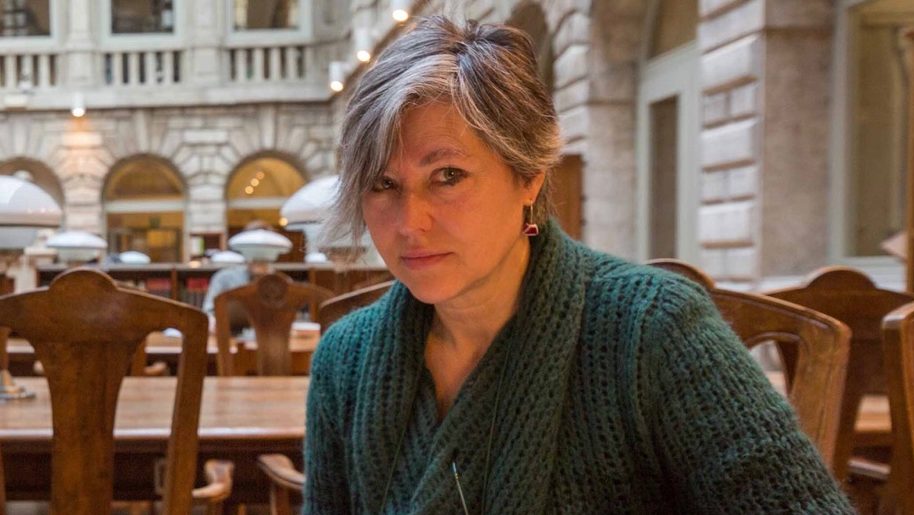
The weeds of Venice: little stories of plant and human resistance, by Tiziana Plebani, is given in the chapter on protest in Venice, an Odyssey. Here you can read the whole poem in the English translation by Daniele Pio Buenza.

The weeds of Venice: little stories of plant and human resistance, by Tiziana Plebani, is given in the chapter on protest in Venice, an Odyssey. Here you can read the whole poem in the English translation by Daniele Pio Buenza.
The weeds of Venice: little stories of plant and human resistance
The weeds of Venice: little stories of plant and human resistance
Before, there used to be fields.
Before, as well as the water and the mudflats, there were fields and grass and also us, to be the masters. Next to vineyards, wheat and barley.
They were uprooting us. But not too much. Because they knew that in times of famine, as needed, we were good enough, raw or cooked in soups, omelets, bread.
And the animals did have to graze after all.
Until the wheat came from Pannonia to feed the great city, in June the fields were yellow with ears of wheat; we dwelt at ease in the cracks of the soil and filled the poorest canteens.
Before the cobblestones, we were there
and we accompanied the flow of the centuries.
We are not all the same.
 Some settled from the outside, like the amaranth, whose seeds sneaked into the ships returning from the New World, where they were the relished food of the Aztecs and the Mayans.
Some settled from the outside, like the amaranth, whose seeds sneaked into the ships returning from the New World, where they were the relished food of the Aztecs and the Mayans.
Some others were brought from the sea, from the wind, stuck to the hulls of the sailboats, as it still happens to men today, and here they found or conquered their place.
They were greeted by a babel of tongues, so many were the lands from which the people who made landfall in the lagoon came.
Before, we were there and we have always stayed, even if reduced, eradicated, weeded like the inhabitants of these islands made of finely worked stone.
As soon as there is lack of attention we try to regain ground, what has been taken from us.
In the margins of the city ignored by the tourist horde, we take a place, occupy spaces, expand.
Where the steps are not hurried, where the rumbling of trolleys does not make itself heard,
we sometimes stand alone.
We would like to clothe the fields as once, to remember the green soul of the stone lagoon.
We ask flies to do the work of bees, so rare in this habitat.
And we whisper to them, saying: ‘get your wings dirty of our seeds, and flap them everywhere, so that we may take root, in spite of the exterminators.’
We start quietly, when the spring warms the air, we appear out of nowhere and throw seeds further afield.
We first advance in tiny ranks, through imaginary paths,
then, especially in summer,
we are seized by an irrepressible desire to cover the paving stones, to erase the trace of man.
To give us a hand, it is often the clover, which is not afraid of anything.
Other times, more cautiously, we send the pellitory to reconnoitre. It makes do with little.
It climbs on the walls, crawls on the gutters but, in truth, it hides a great ambition,
it wants to impress and thus it looks for a stage to perform on.
The peaceful purslane, instead, prefers to be more secluded, it stretches out 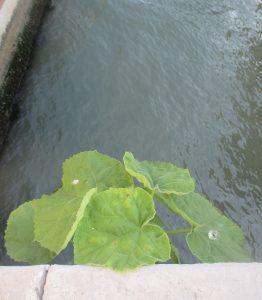 under the hottest sun, clings to the steps of the bridges and, benevolent, observes the passersby;
under the hottest sun, clings to the steps of the bridges and, benevolent, observes the passersby;
while the sea fennel, if left undisturbed, in no time at all covers the banks along the canals,
it covers them of cheerful inflorescences and
it amiably converses with the boats.
We are of many different kinds and all mostly appetizing, even if humans nowadays turn their noses down at us;
we taste of goodness, like the goosefoot, which has the flavor of spinach, or like the many families of chicory, dandelion and crabgrass, which has leaves that are savory and just a little bitter, just enough.
Or we have medicinal properties, just like the bitter dock, which grows in thick tufts.
We dress with ears and stems; with long or round, hairy, serrated or smooth leaves,
we dare to give unexpected flowers, which no one notices but which we give away with generous benevolence.
We grow out of spite, in the ravines, in gaps between the bricks, we scale walls,
climb bridges,
if necessary, we stretch diagonally and take root at an angle.
And we bless the rain when it comes to quench our thirst and cleanse us of dust.
Some of us dream of being a tree, of standing upright and providing shade to the sun-baked city.
And so, if undisturbed, they grow out of all proportion.
During the day we accompany the steps of those who enter the church,
we monitor the passage of boats from the bridges
and we spy on the life of others from the Istrian stone steps.
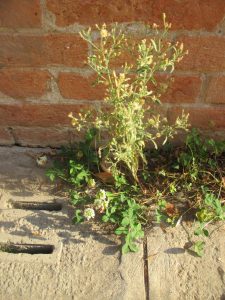 The beauty of this city infects us and we dream of being able to be part of its kaleidoscope of images:
The beauty of this city infects us and we dream of being able to be part of its kaleidoscope of images:
we bring to mind a Mondrian in the hidden alleys,
we create compositions in tune with the cracks in the wall,
or, shamelessly, we compete with the gondolas’ irons.
We make the sparkle of the Istrian stone and the redness of the brick stand out
and we accentuate the veining and the roughness of each stone.
None of the signs of the city is alien to us, not even those that belong to the cry of modernity
and so we defiantly approach the graffiti of the youngsters
because our vegetable colors are artists’ palettes.
But, above all, we strive to remedy the carelessness and lack of love that reign everywhere:
we repair the mistreated paving stones, chipped, broken by the incompetence of the works,
we close and patch up their holes,
we hide the cables that pass through,
we give grace to pipes and ducts,
we hide waste.
Our lives are clandestine and ignored; we are kind strangers, superfluous presences, poor relatives just like, in these times, the inhabitants of the stone city.
Our fibers appear docile, but they are indomitable and tenacious, dense of chlorophyll, swollen with lifeblood.
Each of us chooses its own place, some under the scorching sun, some sheltered from its rays,
some love loneliness
but generally we do not disdain company and we often mix with pleasure
and if some among us raise their voices, we can keep things under control.
Is our life short? Oh yes.
We know that at the end of the summer weeders will come, they will burn our 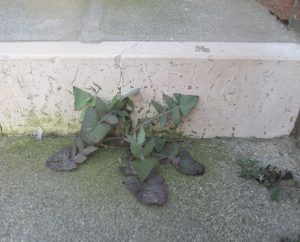 roots with flames, they will pursue racemes, leaves, inflorescences and stems.
roots with flames, they will pursue racemes, leaves, inflorescences and stems.
Perhaps no one will notice our disappearance,
maybe we won’t leave any nostalgia behind.
The city will be whiter and without the dash of our colors.
But we will return on time next year and so the effort to eradicate us will have been useless
because our seeds are stuck in the cracks of the stones and of the paving slabs,
penetrated into the crevices of masonry and bridges
and like the sand and the clay, which welded the forest of wooden piles underwater, we have woven an underground network that tightens the city and makes it compact.
We resist.
We resist like the citizens of this city and we would like to share their dreams. We offer them lives of debris, fragments of beauty, plant wonders.
From below, there where we are, we give to those who pay attention to us the courage and hope to believe in a Venice made not only of stone, not only of voracious and hasty looks but a place to live, linger,
grow and maybe, one day, become trees.
Before, there used to be fields.
Before, as well as the water and the mudflats, there were fields and grass and also us, to be the masters. Next to vineyards, wheat and barley.
They were uprooting us. But not too much. Because they knew that in times of famine, as needed, we were good enough, raw or cooked in soups, omelets, bread.
And the animals did have to graze after all.
Until the wheat came from Pannonia to feed the great city, in June the fields were yellow with ears of wheat; we dwelt at ease in the cracks of the soil and filled the poorest canteens.
Before the cobblestones, we were there
and we accompanied the flow of the centuries.
We are not all the same.
Some settled from the outside, like the amaranth, whose seeds sneaked into the ships returning from the New World, where they were the relished food of the Aztecs and the Mayans.
Some others were brought from the sea, from the wind, stuck to the hulls of the sailboats, as it still happens to men today, and here they found or conquered their place.
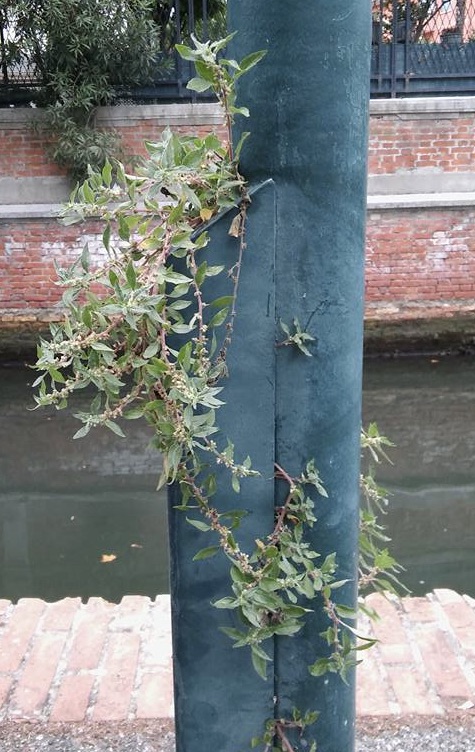
They were greeted by a babel of tongues, so many were the lands from which the people who made landfall in the lagoon came.
Before, we were there and we have always stayed, even if reduced, eradicated, weeded like the inhabitants of these islands made of finely worked stone.
As soon as there is lack of attention we try to regain ground, what has been taken from us.
In the margins of the city ignored by the tourist horde, we take a place, occupy spaces, expand.
Where the steps are not hurried, where the rumbling of trolleys does not make itself heard,
we sometimes stand alone.
We would like to clothe the fields as once, to remember the green soul of the stone lagoon.
We ask flies to do the work of bees, so rare in this habitat.
And we whisper to them, saying: ‘get your wings dirty of our seeds, and flap them everywhere, so that we may take root, in spite of the exterminators.’
We start quietly, when the spring warms the air, we appear out of nowhere and throw seeds further afield.
We first advance in tiny ranks, through imaginary paths,
then, especially in summer,
we are seized by an irrepressible desire to cover the paving stones, to erase the trace of man.
To give us a hand, it is often the clover, which is not afraid of anything.
Other times, more cautiously, we send the pellitory to reconnoitre. It makes do with little.
It climbs on the walls, crawls on the gutters but, in truth, it hides a great ambition,
it wants to impress and thus it looks for a stage to perform on.
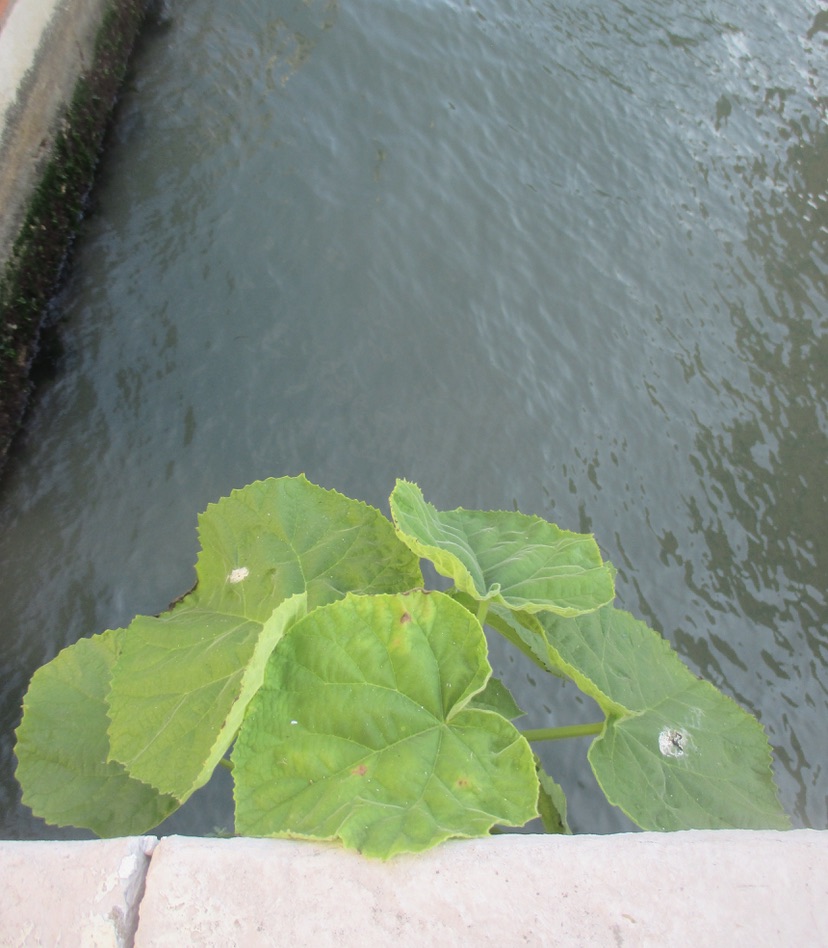
The peaceful purslane, instead, prefers to be more secluded, it stretches out under the hottest sun, clings to the steps of the bridges and, benevolent, observes the passersby;
while the sea fennel, if left undisturbed, in no time at all covers the banks along the canals,
it covers them of cheerful inflorescences and
it amiably converses with the boats.
We are of many different kinds and all mostly appetizing, even if humans nowadays turn their noses down at us;
we taste of goodness, like the goosefoot, which has the flavor of spinach, or like the many families of chicory, dandelion and crabgrass, which has leaves that are savory and just a little bitter, just enough.
Or we have medicinal properties, just like the bitter dock, which grows in thick tufts.
We dress with ears and stems; with long or round, hairy, serrated or smooth leaves,
we dare to give unexpected flowers, which no one notices but which we give away with generous benevolence.
We grow out of spite, in the ravines, in gaps between the bricks, we scale walls,
climb bridges,
if necessary, we stretch diagonally and take root at an angle.
And we bless the rain when it comes to quench our thirst and cleanse us of dust.
Some of us dream of being a tree, of standing upright and providing shade to the sun-baked city.
And so, if undisturbed, they grow out of all proportion.
During the day we accompany the steps of those who enter the church,
we monitor the passage of boats from the bridges
and we spy on the life of others from the Istrian stone steps.
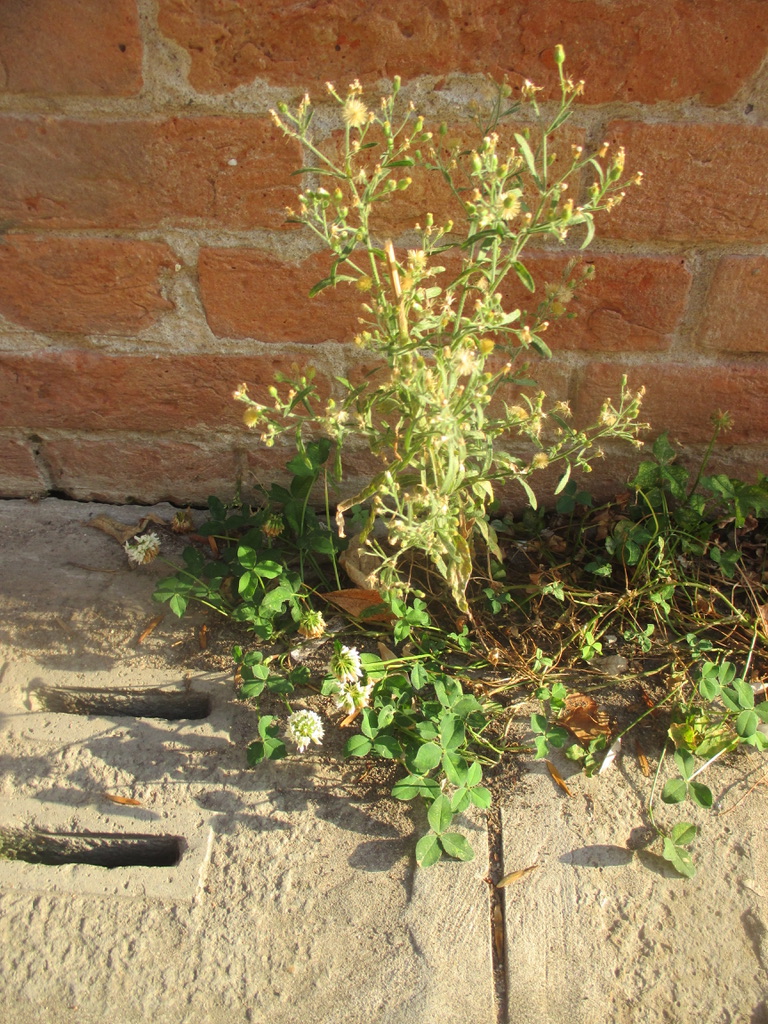
The beauty of this city infects us and we dream of being able to be part of its kaleidoscope of images:
we bring to mind a Mondrian in the hidden alleys,
we create compositions in tune with the cracks in the wall,
or, shamelessly, we compete with the gondolas’ irons.
We make the sparkle of the Istrian stone and the redness of the brick stand out
and we accentuate the veining and the roughness of each stone.
None of the signs of the city is alien to us, not even those that belong to the cry of modernity
and so we defiantly approach the graffiti of the youngsters
because our vegetable colors are artists’ palettes.
But, above all, we strive to remedy the carelessness and lack of love that reign everywhere:
we repair the mistreated paving stones, chipped, broken by the incompetence of the works,
we close and patch up their holes,
we hide the cables that pass through,
we give grace to pipes and ducts,
we hide waste.
Our lives are clandestine and ignored; we are kind strangers, superfluous presences, poor relatives just like, in these times, the inhabitants of the stone city.
Our fibers appear docile, but they are indomitable and tenacious, dense of chlorophyll, swollen with lifeblood.
Each of us chooses its own place, some under the scorching sun, some sheltered from its rays,
some love loneliness
but generally we do not disdain company and we often mix with pleasure
and if some among us raise their voices, we can keep things under control.
Is our life short? Oh yes.
We know that at the end of the summer weeders will come, they will burn our roots with flames, they will pursue racemes, leaves, inflorescences and stems.
Perhaps no one will notice our disappearance,
maybe we won’t leave any nostalgia behind.
The city will be whiter and without the dash of our colors.

But we will return on time next year and so the effort to eradicate us will have been useless
because our seeds are stuck in the cracks of the stones and of the paving slabs,
penetrated into the crevices of masonry and bridges
and like the sand and the clay, which welded the forest of wooden piles underwater, we have woven an underground network that tightens the city and makes it compact.
We resist.
We resist like the citizens of this city and we would like to share their dreams. We offer them lives of debris, fragments of beauty, plant wonders.
From below, there where we are, we give to those who pay attention to us the courage and hope to believe in a Venice made not only of stone, not only of voracious and hasty looks but a place to live, linger,
grow and maybe, one day, become trees.
Le erbe matte di Venezia: piccola storia di resistenza vegetale e umana
Prima c’erano i campi.
Prima, oltre all’acqua, alle velme, c’erano l’erba e i campi e anche noi a far da padrone. Accanto alle vigne, al frumento e all’orzo.
Ci strappavano via. Ma non troppo. Perché sapevano che in tempo di carestia noi, alla bisogna, andavamo bene, crude o cotte in zuppe, frittate, pane.
E poi gli animali dovevano pur brucare.
Fino a quando il grano non giunse dalla Pannonia per nutrire la grande città, in giugno i campi erano gialli di spighe e nelle crepe della terra noi dimoravamo a nostro agio e riempivamo le mense più povere.
Prima del selciato c’eravamo noi
e abbiamo accompagnato lo scorrere dei secoli.
Non tutte le stesse.
Qualcuna si accomodò da fuori, come l’amaranto i cui semi si intrufolarono nelle navi di ritorno dal Nuovo Mondo, dove erano gradito cibo degli Aztechi e dei Maya.
Qualcuna altra venne portata dal mare, dal vento, attaccata agli scafi dei velieri, come succede ancora oggi agli uomini, e qui trovò posto o se lo conquistò.
L’accolse una babele di lingue, tante erano le terre da cui giunse la gente che approdò in laguna.
Prima c’eravamo noi e siamo sempre rimaste, anche se ridotte, sradicate, estirpate come gli abitanti di queste isole di pietra finemente lavorata.
Appena c’è distrazione cerchiamo di riconquistare terreno, quello che ci è stato tolto.
Nei margini della città ignorati dall’orda del turismo, prendiamo posto, occupiamo spazi, ci allarghiamo. Dove i passi non sono concitati, dove il frastuono dei trolley non si fa sentire,
ci ergiamo anche solitarie.
Vorremmo rivestire i campi come un tempo, ricordare l’anima verde della laguna di pietra.
Chiediamo alle mosche di fare il lavoro delle api, così rare in questo habitat.
Sussurriamo loro: sporcatevi le ali dei nostri semi, sbattetele dovunque, così da farci attecchire, in barba agli estirpatori.
Cominciamo in sordina, quando la primavera intiepidisce l’aria, spuntiamo dal nulla e gettiamo semi più in là.
Avanziamo dapprima in schiere minuscole e con percorsi immaginari,
poi, specie d’estate,
ci prende una smania irrefrenabile di ricoprire i masègni, di cancellare la traccia dell’uomo.
A darci man forte ci si mette sovente il trifoglio che non ha paura di nulla.
Altre volte, più guardinghe, mandiamo in perlustrazione la parietaria. Lei si accontenta di poco.
Si arrampica sui muri, striscia sulle grondaie ma in verità nasconde una grande ambizione,
vuole stupire e cerca un palcoscenico su cui esibirsi.
La paciosa portulaca preferisce invece stare più appartata, si distende sotto il sole più bruciante, si aggrappa ai gradini dei ponti e osserva benevola chi passa,
mentre il finocchio marino se lasciato indisturbato in quattro e quattr’otto riveste le rive lungo i canali,
le tappezza di allegre infiorescenze e
conversa amabilmente con le barche.
Siamo di tante sorte diverse e tutte per lo più appetitose, anche se gli umani ormai ci snobbano;
sappiamo di buono come il farinello che ha il gusto dello spinacio o come le tante famiglie di cicoria, tarassaco o di gramigna, dalle foglie sapide e amare appena un po’, quanto basta.
O possediamo proprietà medicinali come la lingua di vacca che spunta a fitti cespi.
Ci rivestiamo di spighe, steli, foglie lunghe o rotonde, pelose, seghettate o lisce,
azzardiamo fiori imprevisti, che nessuno nota ma noi li regaliamo con generosa benevolenza.
Cresciamo per dispetto, negli anfratti, tra le fessure dei mattoni, scaliamo i muri,
ci arrampichiamo sui ponti,
se necessario, ci allunghiamo in diagonale e attecchiamo di sbieco.
E benediciamo la pioggia quando giunge a dissetarci e a mondarci dalla polvere.
Qualcuna di noi sogna d’essere albero, di ergersi verticale e offrire ombra alla città assolata.
E così, se indisturbata, cresce a dismisura.
Durante il giorno accompagniamo i passi di chi entra in chiesa,
sorvegliamo dai ponti il passaggio delle barche
e spiamo la vita altrui dai gradini di pietra d’Istria.
La bellezza di questa città ci contagia e sogniamo di poter far parte del suo caleidoscopio di immagini:
suggeriamo un Mondrian nelle calli nascoste,
creiamo composizioni intonate alle sbrecciature del muro,
o, sfacciate, ci mettiamo in competizione con i ferri delle gondole.
Facciamo risaltare la lucentezza della pietra d’Istria, il rosso del mattone
e accentuiamo le striature e le rugosità di ogni pietra.
Nulla ci è estraneo dei segni della città, neppure quelli che appartengono al grido della modernità
e così ci accostiamo con sfida ai graffiti dei giovani
perché le nostre tinte vegetali sono tavolozze d’artista.
Ma soprattutto ci sforziamo di rimediare all’incuria e al disamore che regnano dovunque:
ripariamo i masègni maltrattati, scheggiati, spezzati dall’imperizia dei lavori,
chiudiamo e rappezziamo le loro buche,
nascondiamo i cavi passanti,
regaliamo grazia a tubi e condutture,
occultiamo rifiuti.
Le nostre sono vite clandestine e ignorate; noi siamo estranei gentili, presenze superflue, parenti poveri come ormai gli abitanti della città di pietra.
Le nostre sono tuttavia fibre docili all’apparenza ma indomite e tenaci, dense di clorofilla, gonfie di linfa vitale.
Ciascuna di noi sceglie un proprio posto, chi sotto al sole cocente, chi al riparo dai suoi raggi,
qualcuna ama la solitudine
ma per lo più non disdegniamo la compagnia e sovente ci mescoliamo con gusto
e se c’è qualcuna che fa la voce grossa, sappiamo tenerla a bada.
La nostra vita è breve? Oh sì.
Sappiamo che alla fine dell’estate passeranno gli sradicatori, bruceranno con le fiamme le nostre radici, inseguiranno racemi, foglie, infiorescenze e steli.
Forse nessuno si accorgerà della nostra sparizione,
forse non lasceremo alle spalle della nostalgia.
La città sarà più bianca e senza il guizzo dei nostri colori.
Ma ci ripresenteremo puntualmente l’anno a venire e così lo sforzo di estirparci sarà stato inutile
perché i nostri semi sono conficcati nelle fessure delle pietre e dei masègni,
penetrati negli anfratti delle murature e dei ponti
e come il caranto, che ha saldato la foresta di pali sott’acqua, noi abbiamo intrecciato una rete sotterranea che stringe e rende compatta la città.
Noi resistiamo.
Resistiamo come i cittadini di questa città e vorremmo condividerne i sogni. Offriamo a loro vite di risulta, frammenti di bellezza, stupori vegetali.
Dal basso, lì dove siamo, infondiamo a chi ci presta attenzione il coraggio e la speranza per credere a una Venezia non solo di pietra, di sguardi voraci e frettolosi ma un luogo per vivere, sostare,
crescere e forse divenire un giorno alberi.
Venice’s mad weeds: a small history of plant and human resistance

